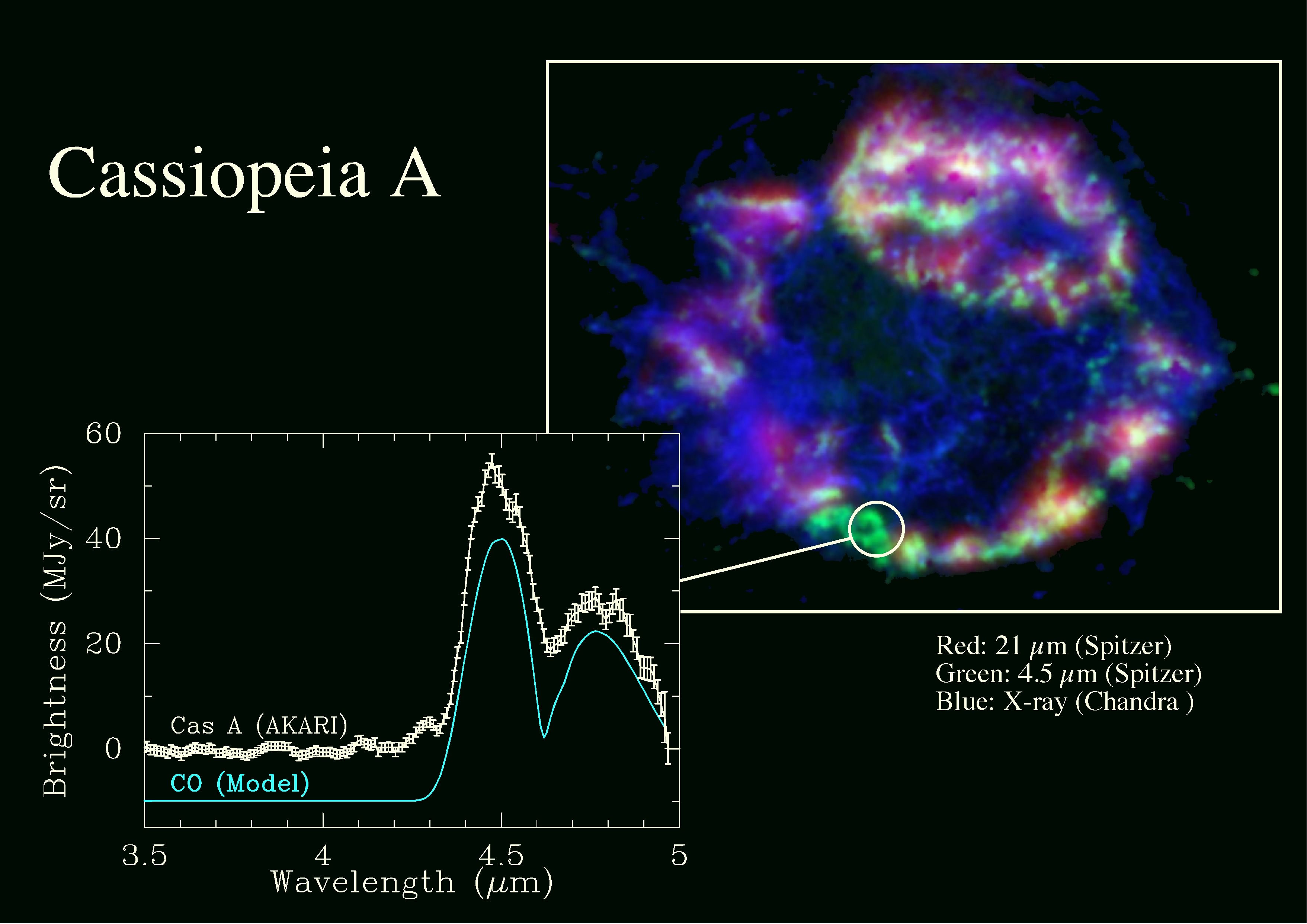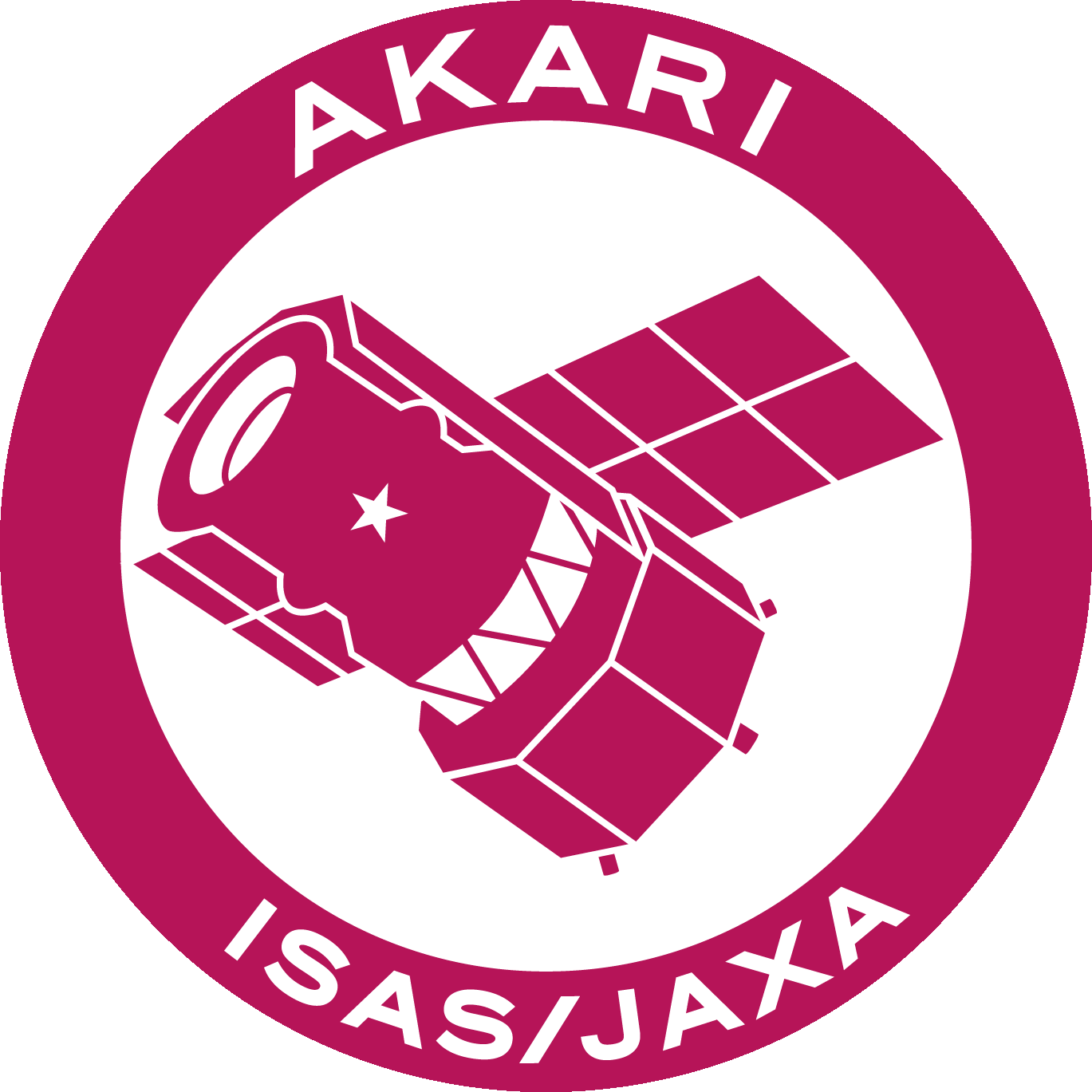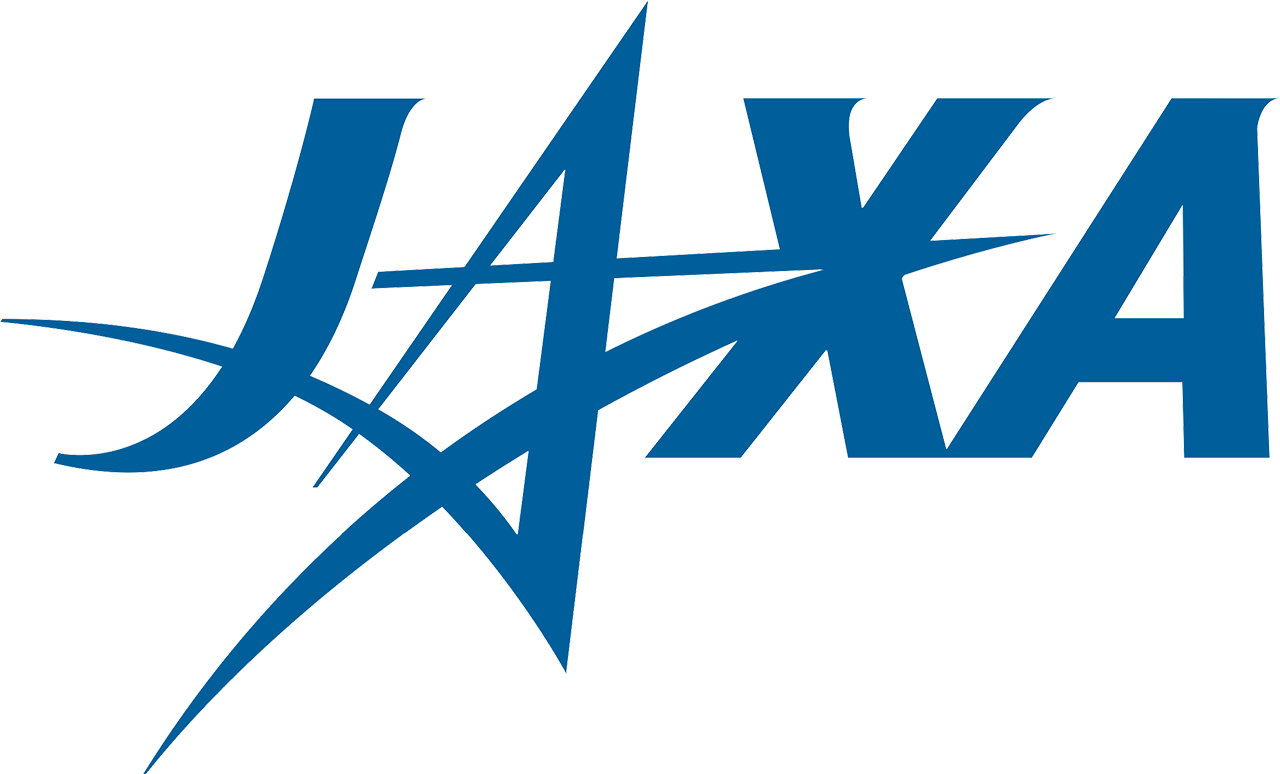AKARI Results
AKARI found carbon monoxide molecules embedded in ten million degree gas
A scientific team using the Japanese AKARI infrared space observatory finds carbon monoxide (CO) molecules in the ten million degree gas associated with the young supernova remnant Cassiopeia A (Cas A). The team is led by Dr. Jeonghee Rho, who holds a joint appointment at the SETI Institute, and at the SOFIA Science Center at NASA Ames Research Center (both located in Mountain View California). Theoretically it was neither predicted nor expected to find the carbon monoxide molecule associated with a highly energetic supernova remnant. Energetic electrons and heavy-element atoms produced by nuclear processes in supernovae should have destroyed these molecules. This finding could change our current understanding of the cycle of carbon and molecules in the interstellar gas and dust clouds.
Infrared spectra obtained by AKARI have detected a broad feature with a double-peaked profile (see Figure 1 left). A dozen spectra reveal CO features similar to this across the angular extent of Cas A. The CO emission is specially detected not only from the bright ring of shocked ejecta but also from the central region where unshocked ejecta are located. The CO at the center of Cas A contains material which has been relatively unchanged since a few years after the original supernova explosion. The spectral model applied to these spectra indicates that the broad feature is being composed of a few ten thousand spectral lines produced by CO (see Figure 1 right). Cas A is 330 years old and located at a distance of approximately 11 thousand light years in the direction of the well-known W-shaped constellation of Cassiopeia.

Figure 1: Mosaicked CO (Spitzer 4.5 micronmeters, green), Silica dust (Spitzer IRS 21 micronmeters, red), X-ray (Chandra, blue) maps. CO molecules are embedded in ten million degree gas; AKARI spectra have now allowed us to identify the synchrotron-subtracted Spitzer IRAC band 2 image at 4.5 micronmeters as a map of the CO distribution in Cas A.
"When I saw these beautiful AKARI spectra, I was excited by the fact that carbon monoxide molecules are located within a ten million degree gas. It is like detecting CO molecules right at the center of the Sun. The Universe is full of surprises!" said Dr. Rho.' CO molecules are common in space between stars, but these molecules are usually in a very cold state. The team captured signals from rare CO molecules that are warm (2000 K) and extremely dense (10 million molecules per cubic centimeter) by detecting this broad CO spectral feature in the infrared. Observations from multiple space-based and ground-based observatories have been made in the discovery of CO in Cas A. An infrared image of Cas A that was made with NASA Spitzer Infrared Array Camera (IRAC) at a wavelength of 4.5 micronmeters unexpectedly showed bright emission from Cas A. This result led the authors to suspect that the emission may be produced by CO as well as the emission from other heavy elements. Follow-up near-infrared images with the Palomar Hale 5-meter (200-inch) telescope indicated a strong possibility that CO is present in Cas A. However, until AKARI detected CO through a spectroscopic observation, the presence of this molecule within this young supernova remnant could not be proved for certain.
By combining AKARI observations with the Spitzer image, "bullets" of CO molecules were shown to exist. These bullets have survived in the ten million degree gas of the 330 year-old supernova remnant. "The CO detection challenges our understanding of how molecules form in supernova ejecta and evolve with time. Are the CO molecules observed with AKARI produced after the explosion? Have they survived until now, sheltered in these clumps? Or can this warm CO have reformed in the remnant? Many intriguing questions arise from these very exciting observational data." said Professor Isabelle Cherchneff, a theoretician at the University of Basel in Switzerland.
Supernovae are one of major sources providing heavy elements to the interstellar medium; however, our finding implies that carbon is locked in CO and thus a lot of carbon is not free to return to the interstellar medium. If CO locks up C and O in molecular form, it is possible that other molecular species such as SiO lock up other heavy elements, too. Detecting CO molecules in supernova ejecta would change our understanding of astrochemistry, dust formation and the origin of huge quantities of dust observed in the early Universe.
AKARI (ASTRO-F) is an infrared astronomical satellite developed and operated by Japan Aerospace Exploration Agency with the participation of ESA, in cooperation with institutes of Europe and Korea. It was launched on 21 February 2006. After its launch it was named AKARI which means light in Japanese. Its primary mission was to survey the entire sky in near-, mid- and far-infrared, through its 68.5 cm (27.0 in) aperture telescope.
The discovery of warm CO molecules with the AKARI Infrared Astronomical Satellite has just been published in the Astrophysical Journal Letters 747, Issue 1 on Feb 8, 2012 entitled by "Spectroscopic detection of Carbon Monoxide in the Young Supernova Remnant Cassiopeia A". Research team members in addition to Dr. Jeonghee Rho are Drs. Takashi Onaka at University of Tokyo, Jan Cami at University of Western Ontario, and William Reach at Universities Space Research Association.
Materials
- Figure 1
- High Resolution
- Map Image (© J. Rho/NASA/JPL-Caltech/CXC)
- Spectra (© J. Rho/JAXA/SETI Institute)
Contact Information
Dr Jeonghee Rho, SETI Institute and SOFIA Science Center
Phone: +1-650-604-4134
Fax: +1-650-604-1984





